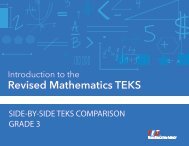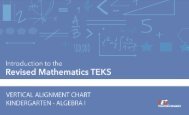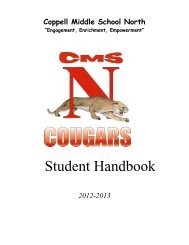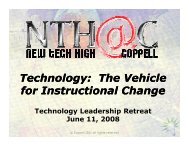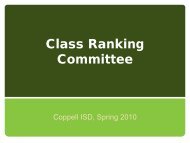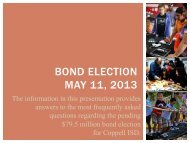Grade 2 - Coppell Independent School District
Grade 2 - Coppell Independent School District
Grade 2 - Coppell Independent School District
- No tags were found...
You also want an ePaper? Increase the reach of your titles
YUMPU automatically turns print PDFs into web optimized ePapers that Google loves.
<strong>Grade</strong> 2 – MathematicsCurrent TEKS: Number, Operation, andQuantitative ReasoningRevised TEKS (2012) Supporting Information Notes–2(2)(A) Number, operation, andquantitative reasoning. The studentdescribes how fractions are used to name partsof whole objects or sets of objects.The student is expected to use concretemodels to represent and name fractionalparts of a whole object (withdenominators of 12 or less).2(2)(B) Number, operation, andquantitative reasoning. The studentdescribes how fractions are used to name partsof whole objects or sets of objects.The student is expected to use concretemodels to represent and name fractionalparts of a set of objects (withdenominators of 12 or less).2(3)(D) Number and operations. Thestudent applies mathematical processstandards to recognize and represent fractionalunits and communicates how they are used toname parts of a whole.The student is expected to identifyexamples and non-examples of halves,fourths, and eighths.Specificity has been added to illustrate howstudents might justify their thinking related tohalves, fourths, and eighths.The content of this SE was moved to grade 3:Number and operations3(3)(E)–+2(2)(C) Number, operation, andquantitative reasoning. The studentdescribes how fractions are used to name partsof whole objects or sets of objects.The student is expected to use concretemodels to determine if a fractional part ofa whole is closer to 0, ½, or 1.2(3)(A) Number, operation, andquantitative reasoning. The student addsand subtracts whole numbers to solveproblems.The student is expected to recall andapply basic addition and subtraction facts(to 18).2(4)(A) Number and operations. Thestudent applies mathematical processstandards to develop and use strategies andmethods for whole number computations inorder to solve addition and subtractionproblems with efficiency and accuracy.The student is expected to recall basicfacts to add and subtractwithin 20 with automaticity.This skill, when coupled with revised SE3(1)(C), becomes part of the revised SE3(3)(H).Students are expected to recall basic additionand subtraction facts.When coupled with revised SE, students maystill be asked to apply these basic facts.The level of skill with “automaticity” requiresquick recall of basic facts within 20 with speedand accuracy at an unconscious level.Automaticity is part of procedural fluency and,as such, should not be overly emphasized as anisolated skill.Automaticity with basic addition andsubtraction facts allows students to explorericher applications of addition and subtraction.This is an increase from within 18.©2013 Texas Education Agency. All Rights Reserved 2013 Introduction to the Revised Mathematics TEKS: Side-by-Side TEKS Comparison 6






